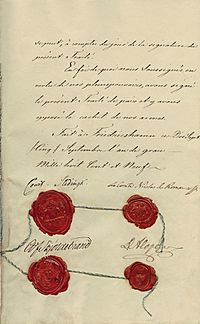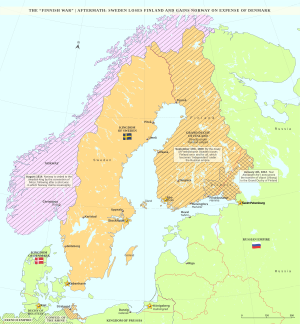Treaty of Fredrikshamn facts for kids

final page
|
|
| Signed | 17 September 1809 |
|---|---|
| Location | Fredrikshamn, Russia |
| Original signatories |
|
The Treaty of Fredrikshamn (also known as the Treaty of Hamina) was a very important peace agreement. It was signed between Sweden and Imperial Russia on September 17, 1809. This treaty officially ended the Finnish War.
The signing took place in the Finnish town of Hamina, which was called Fredrikshamn back then. Russia was represented by Nikolai Rumyantsev and David Alopaeus. Sweden's representatives were General Kurt von Stedingk and Colonel Anders Fredrik Skjöldebrand. A key part of the treaty was that Sweden gave up its Finnish lands to Russia.
Contents
What the Treaty Changed
The Treaty of Fredrikshamn made big changes to the map of Europe. It decided who owned certain lands.
New Borders for Finland
Sweden gave up several areas to Russia. These included parts of Lappland and Västerbotten. These areas were east of the Tornio River and Muonio River. Sweden also gave up the Åland islands and all other provinces to their east.
These lands became a new area called the Grand Duchy of Finland. This Grand Duchy also included parts of Karelia and Savonia. Russia had taken these areas in the 1700s. They were later called Old Finland. In 1812, these older parts were joined with the new lands to form Viborg County.
Finland's New Beginning
This treaty, along with the Diet of Porvoo in 1809, was a major step for Finland. It created the autonomous Grand Duchy. This meant Finland could have its own government and rules.
This new freedom helped Finnish culture grow stronger. The Finnish language became more important. Eventually, these changes led to Finland becoming an independent country in 1917.
Promises and Challenges
The treaty mentioned that Emperor Alexander promised to keep Finland's old laws and special rights. However, the treaty did not officially guarantee these promises. Russia refused to add strong guarantees, and Sweden could not insist.
Promises like these were common in peace treaties. But they were often ignored later. Many years later, during a time when Russia tried to make Finland more Russian, the Russian government said the treaty was not broken. They argued that no other country had the right to get involved. They said it was only up to the Emperor who made the original promise.
The Åland Islands
During the treaty talks, Swedish representatives tried hard to keep the Åland islands. These islands were very important because they were close to Stockholm, Sweden's capital. Napoleon even called them "the fore-posts of Stockholm."
The people on the Åland islands were Swedish in culture and language. But at that time, such facts did not matter much. Later, in the 1800s, the British also became interested in the Åland islands. After the Crimean War, the islands were made a neutral zone. This meant no military forces could be there. This rule was part of the Åland Convention in the Treaty of Paris (1856).
After the Treaty
After the Treaty of Fredrikshamn, Russia and Sweden became allies. On April 5, 1812, they formed an alliance against France. They planned to attack Swedish Pomerania, which France had taken over. Russia also promised to make Denmark give Norway to Sweden. It was hoped that Great Britain would join this alliance, but that did not happen. These plans did not come true because Napoleon's invasion of Russia changed everything.


